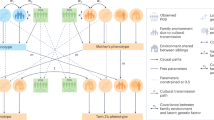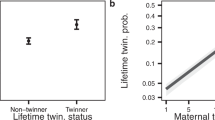Abstract
TWINS, together with other multiple human births, have always been of interest to the society of which they are members. In primitive communities, twins are regarded as being possessed of supernatural powers, which may or may not prove propitious to the group. Within the last seventy years, social scientists have made use of twins in an effort to solve the vexed question of the respective influences of heredity and environment on the formation of human character and physique.
This is a preview of subscription content, access via your institution
Access options
Subscribe to this journal
Receive 51 print issues and online access
$199.00 per year
only $3.90 per issue
Buy this article
- Purchase on Springer Link
- Instant access to full article PDF
Prices may be subject to local taxes which are calculated during checkout
Similar content being viewed by others
References
Newman, H. H., Freeman, F. N., and Holzinger, K. J., "Twins: a Study of Heredity and Environment" (University of Chicago Press, 1936), 36.
Galton, F., "Inquiries into Human Faculty and its Development" (New York: Macmillan and Co., 1883), 216–242.
Thorndike, E. J., "Measurement of Twins". Archives of Philosophy, Psychology and Scientific Methods, No. 1 (September 1905), 1–64.
Merriman, C., "The Intellectual Resemblance of Twins", Psychological Monographs, Vol. 33, No. 5 (Princeton, N.J.: Psychological Review Co., 1924).
Wingfield, A. H., "Twins and Orphans: the Inheritance of Intelligence" (London and Toronto: J. M. Dent and Sons, Ltd., 1928).
Hogben, L., "Genetic Principles in Medicine and Social Science" (London: Williams and Norgate, 1931).
Rosanoff, A. J., Handy, L. M., Plessett, I. R., and Brush, S., "The Etiology of so-called Schizophrenic Psychoses". Amer. J. Psychiatry, 140, 247 (September 1934), 247–286.
See ref. 1.
Ref. 1, p. 93.
Ref. 1, p. 250.
Ref. 1, p. 191.
Lange, J., "Crime as Destiny", translated by Charlotte Haldane (1931).
Rights and permissions
About this article
Cite this article
SQUIRES, J. STUDIES OF TWINS IN THE SOCIAL SCIENCES. Nature 152, 437–440 (1943). https://doi.org/10.1038/152437a0
Issue Date:
DOI: https://doi.org/10.1038/152437a0
Comments
By submitting a comment you agree to abide by our Terms and Community Guidelines. If you find something abusive or that does not comply with our terms or guidelines please flag it as inappropriate.



